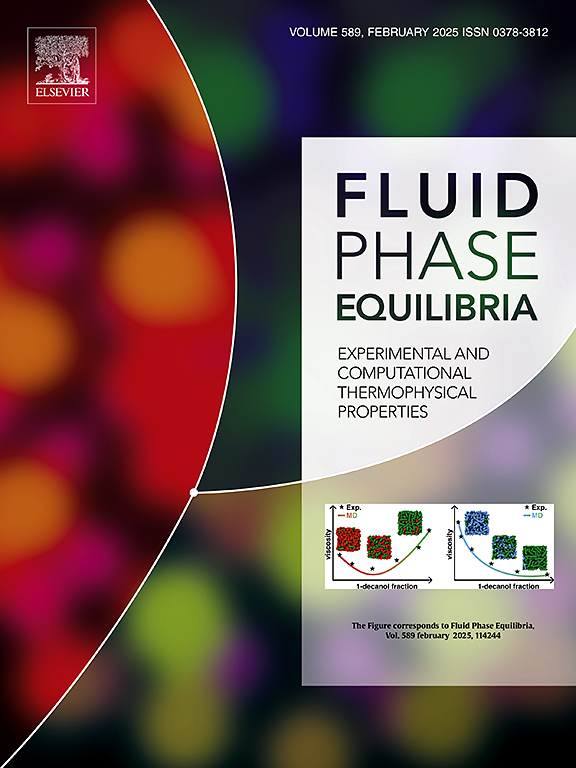A robust setup for efficient characterization of multicomponent vapor-liquid equilibria using Raman spectroscopy
IF 2.8
3区 工程技术
Q3 CHEMISTRY, PHYSICAL
引用次数: 0
Abstract
Vapor-liquid equilibrium (VLE), a crucial thermodynamic property in diverse industrial processes, assumes paramount significance in the development, optimization, and operation of separation processes and various applications. Despite their central role, large sample volumes, long measurement times and the handling of the apparatus are a challenge for the precise determination of VLE data. In response to these challenges, we present an innovative Raman spectroscopy-based measurement setup that enables fast, accurate and user-friendly characterization of VLE. The application of Raman spectroscopy enables non-invasive analysis of vapor and liquid-phases in small sample volumes (<3 ml) for multiple VLE data points. The usage of a compact isothermal VLE measurement cell ensures rapid and reliable VLE control. The combination of the equilibrium cell with a highly confocal fiber-coupled Raman probe in backscattering configuration and a high-throughput spectrometer establishes an efficient setup for quantifying VLE data in a broad range of conditions. The setup has been validated for vapor pressure curves of methyl tert‑butyl ether (MTBE), isooctane (2,2,4-trimethylpentane) and cyclohexane for a temperature range of 283.15 K to 333.15 K and the measurement of the binary VLE MTBE-isooctane at 318 .15K. the setup allows a highly efficient access to VLE data of industrial relevance.

利用拉曼光谱有效表征多组分气液平衡的鲁棒装置
汽液平衡(VLE)是各种工业过程中重要的热力学性质,在分离过程的开发、优化和操作以及各种应用中具有至关重要的意义。尽管它们具有核心作用,但大样本量,长测量时间和设备的处理对VLE数据的精确测定是一个挑战。为了应对这些挑战,我们提出了一种创新的基于拉曼光谱的测量装置,可以快速,准确和用户友好地表征VLE。拉曼光谱的应用可以在小样品体积(< 3ml)中对多个VLE数据点进行蒸汽和液相的非侵入性分析。使用紧凑的等温VLE测量单元确保快速可靠的VLE控制。平衡池与高共聚焦光纤耦合拉曼探针的后向散射配置和高通量光谱仪的组合建立了一个有效的设置,用于在广泛的条件下量化VLE数据。在283.15 K ~ 333.15 K的温度范围内,对甲基叔丁基醚(MTBE)、异辛烷(2,2,4-三甲基戊烷)和环己烷的蒸气压曲线进行了验证,并在318.15 K的温度范围内对二元VLE MTBE-异辛烷进行了测量。该设置允许高效访问与工业相关的VLE数据。
本文章由计算机程序翻译,如有差异,请以英文原文为准。
求助全文
约1分钟内获得全文
求助全文
来源期刊

Fluid Phase Equilibria
工程技术-工程:化工
CiteScore
5.30
自引率
15.40%
发文量
223
审稿时长
53 days
期刊介绍:
Fluid Phase Equilibria publishes high-quality papers dealing with experimental, theoretical, and applied research related to equilibrium and transport properties of fluids, solids, and interfaces. Subjects of interest include physical/phase and chemical equilibria; equilibrium and nonequilibrium thermophysical properties; fundamental thermodynamic relations; and stability. The systems central to the journal include pure substances and mixtures of organic and inorganic materials, including polymers, biochemicals, and surfactants with sufficient characterization of composition and purity for the results to be reproduced. Alloys are of interest only when thermodynamic studies are included, purely material studies will not be considered. In all cases, authors are expected to provide physical or chemical interpretations of the results.
Experimental research can include measurements under all conditions of temperature, pressure, and composition, including critical and supercritical. Measurements are to be associated with systems and conditions of fundamental or applied interest, and may not be only a collection of routine data, such as physical property or solubility measurements at limited pressures and temperatures close to ambient, or surfactant studies focussed strictly on micellisation or micelle structure. Papers reporting common data must be accompanied by new physical insights and/or contemporary or new theory or techniques.
 求助内容:
求助内容: 应助结果提醒方式:
应助结果提醒方式:


